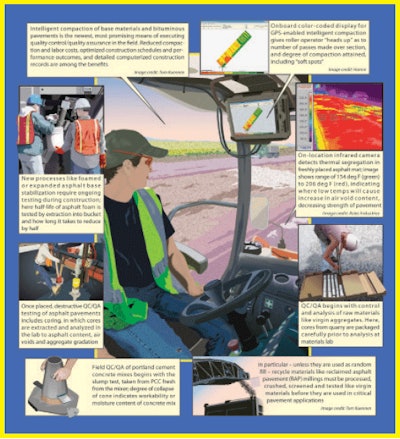
by Tom Kuennen, Contributing Editor
You’ve designed and are building a pavement to resist fatigue and thermal cracking, stripping and raveling in ways that are suggested in Better Roads’ five-part series. But your job isn’t done.
Now is the time to maintain an iron grip on the quality of the construction materials at the source and of construction practice in the field.
Fortunately, a framework exists to make your job easier. Quality control (QC) and quality assurance (QA) practices – adapted from the manufacturing sector – provide a path for staying focused on the way a project is executed in the field.
QC Compared to QA
Quality control, also called process control, is defined as the material producer’s and field contractor’s methodology for testing, inspection and oversight of all materials and processes so you can obtain a quality, constructed product that meets specifications.
If QC describes the observation techniques and activities used to maintain quality in a project, quality assurance describes activity in the quality-control chain that will ensure specs will be achieved and a quality project attained.
In a construction project, QA describes statistically based acceptance specifications, which measure quality characteristics – such as asphalt content, aggregate gradation, concrete compressive strength or soil density.
These are related to pavement performance and can be used to pay the contractor for the level of quality provided, according to Moin Uddin, PhD, E.I.T., East Tennessee State University-Johnson City; Paul M. Goodrum, P.E., Kamyar C. Mahboub, P.E., and Arnold Stromberg, University of Kentucky-Lexington, in their 2012 Transportation Research Board paper: A Solution to Non-Normality in Quality Assurance Acceptance Quality Characteristics Data.
As such, QA exists within a QC structure, quantifying data obtained in the QC process and using it to calculate payment to the contractor. QA refers to the systematic measurement, comparison to a standard, monitoring of processes and an associated feedback loop that prevents errors. QC, on the other hand, is focused on process outputs.
“FHWA’s (Federal Highway Administration) recommended [QA] specification compliance measure, percent within limits (PWL), is typically used to quantify quality provided,” the professors write in their paper. “PWL is based on the assumption that acceptance quality characteristic (AQC) data obtained from a lot or sub-lots are normally distributed, a lot [being] defined as a quantity of similar material, construction or units of product subjected to either an acceptance or process control decision.”
The statistical approach is not foolproof and might shortchange contractors, Uddin, Goodrum, Mahboub and Stromberg say. “If the process shows evidence of a significant departure from normality, then the quality measures calculated may be erroneous,” they write. “When the population distribution is non-normal, AQC data tend to misdirect contractor payments, which can incorrectly penalize contractors who deliver acceptable construction materials and reward contractors who deliver poor construction materials.”
Their paper describes a new statistical approach involving a search algorithm that can substantially reduce pay biases due to non-normality, even when lot sample size is small.
“The method is robust with high accuracy, and it leads to fair and equitable payment to state agencies and contractors,” they say. “[A]ny state highway agency interested in implementing it can easily automate it. Instead of removing or replacing test data that result in non-normality with high spread, state agencies can treat the data as it is and use the proposed method to calculate more accurate pay factors.”


Getting Compaction QC Right
For hot-, warm- and cold-mix asphalt pavements, quality control is required because compaction specifications must be met, and there will be penalties for undercompaction as well as overcompaction.
For the contractor, compaction to spec means 100-percent payment, but it also means the contractor will have accomplished the final requirement that was specified when the project was designed for the pavement’s loading and daily traffic count.
For the public sector client, QC of compaction is important because it proves the pavement meets the criteria set forth in the specifications and that the pavement will perform the way it was intended, including meeting lifecycle cost requirements. The road users benefit, as well.
 Roadtec’s material transfer vehicle (MTV) revolutionized asphalt pavement quality control by reducing aggregate and thermal segregation in mixes, as well as isolating trucks from the paver hopper.
Roadtec’s material transfer vehicle (MTV) revolutionized asphalt pavement quality control by reducing aggregate and thermal segregation in mixes, as well as isolating trucks from the paver hopper.Quality compaction depends on good-quality material coming from the plant. Crews should discuss the day’s paving each day before the work starts. Crews that function as a team, and not individuals, will consistently achieve quality compaction.
QC also will consider delivery of the mix to the jobsite. Undesirable segregation of aggregate within the mix takes place during the haul: The longer the haul, the more the segregation. It also is encouraged by too-fast dumping of asphalt in the paver hopper, so drivers need to dump slowly. Hopefully, the truck will never touch the paver; the resulting bump will cause a discontinuity in the mat, impacting smoothness.
Even as your supplier or staff has verified asphalt content, aggregate content and gradation and temperature of the mix as part of their QA program as it leaves the plant, the mix will contain too much air to support loads. Compaction lowers the total volume of the mix by forcing air from the mix and reducing air voids. The degree of compaction generally is measured as a percent of dense asphalt minus the remaining air voids.
Roller speed, the number of passes, roller pattern, mat temperature and ambient environmental conditions all impact compaction. Test strips are an important part of QC, as they help manage these factors, establishing the roller pattern and optimum number of passes necessary to provide a smooth, well-compacted mat that will last during the lifetime of its usage.
One QC measure demanded by many road agencies for high-level pavements is the use of a material transfer vehicle (MTV), which allows the paver to move without interruption, eliminating trucks bumping the front of the paver. The MTV also mixes asphalt from the truck before it enters the paver, ensuring a mat with consistent material temperature with minimal aggregate segregation.
Thermal segregation in a mat may be detected with a hand-held infrared thermometer or an infrared camera, which will document cooled spots (see illustration, page 5). These spots indicate where low temperatures will cause increases in air void content, decreasing the strength of the pavement.
Essential to the good rolling pattern are foremen and operators who pay attention and know what it takes to produce a quality mat. Consistency can be expected if the crew is knowledgeable.
Density measurements are important for QC and acceptance for agencies and contractors because correct in-place densities are correlated with improved long-term performance of asphalt pavements. These are obtained in the field during construction via nuclear or the new non-nuclear density gauges and by cores of as-built pavements.
Intelligent Compaction
Conventional compaction procedures have some limitations. They provide little or no feedback on the fly. Corings for density measurement are not analyzed until after compaction and may not be representative of the entire section.
Overcompaction can occur, resulting in shattered aggregate and streaks on the mat. Intelligent compaction (IC) of base materials and bituminous pavements is the newest, most promising means of executing quality control/quality assurance in the field.
Reduced compaction and labor costs, optimized construction schedules and performance outcomes and detailed computerized construction records are among the benefits. IC will become an important part of QC/QA in the years to come.
“Intelligent compaction is an equipment-based technology for better quality control that results in longer pavement lives,” according to the FHWA. “IC machines are vibratory rollers with accelerometers mounted on the axle of the front drums, global positioning system, infrared temperature sensors (for asphalt) and on-board computers that can display color-coded maps in real-time to track roller passes, asphalt surface temperatures and stiffness of compacted materials.”
While intelligent compaction technology is applicable to soil compaction as well as asphalt, in 2013, the FHWA has been ramping up its field studies of intelligent compaction for asphalt pavements.
IC devices offer a number of advantages for highway projects, according to the FHWA, including:
• Optimized labor deployment and construction time. Contractors can roll the right amount of material with the right amount of compactive effort (via cumulative stiffness readings) on each pass to ensure long-term performance, enhancing onsite quality control.
• Reduced compaction costs and maintenance requirements. The flexibility to make fewer passes to achieve the correct compaction level – today, measured from detected stiffness – will minimize fuel use and equipment wear and tear, saving time and money.
• Ability to make midcourse corrections. Adjustment during compaction of one layer before additional layers are placed ensures subsurface problems don’t affect the entire road surface. Again, a quality-control issue.
• Ability to maintain construction records. Data from the IC, along with global positioning system (GPS) coordinates of compaction activity, can be downloaded into construction quality databases and stored for future reference. It’s here that IC becomes an integral part of QA, as models of what was compacted, where and when – and at what temperature, in some iterations – can be constructed from the raw data.
“Some IC-equipped rollers use GPS technology to continuously calculate and record the position of the roller, while a measurement system on the roller is continuously determining the stiffness of the hot-mix asphalt material being compacted,” says Michael M. Arasteh, FHWA pavement and materials engineer. “Then, by marrying these two data groups together, it is possible to obtain a map of stiffness or the number of roller passes for the entire pavement surface.”
Temperature variation in mat surfaces can be recorded during breakdown rolling, and this also can become part of the project database. On-board color-coded displays for GPS-enabled intelligent compaction give roller operators a “heads up” as to the number of passes made over a section and the degree of stiffness attained, including “soft spots.”
Ultimately, IC systems will be able to measure and record internal mat temperatures, as well as surface temperatures.
These data will be stored in an on-board computer and then downloaded onto a thumb drive to be taken to the trailer for loading in a construction management, QA program, laptop or handheld device. Or, the data may be sent in real-time via a dedicated cellular line both to the trailer and to corporate headquarters.
Correlating Stiffness, Density
While nuclear and non-nuclear density meters can measure density of compacted asphalt pavements, IC-equipped rollers can’t measure density on the fly. But, it may be possible to extrapolate density based on stiffness measurements, which are an integral part of asphalt IC.
In 2012 and 2013, FHWA’s IC study team attempted to correlate on-board IC readings with actual density. Current IC roller measurement values (IC-MV) are accelerometer-based technology, the values of which vary from manufacturer to manufacturer. But IC-MVs do relate to the stiffness of materials.
To help manage these data, as part of an Intelligent Compaction Pooled Fund project, the Veda software program was developed. “This software is a great first step in addressing one of the biggest barriers to IC implementation, which is a myriad of issues related to handling the massive amount of data produced during the compaction process,” say Robert D. Horan, P.E., The Asphalt Institute; George K. Chang, P.E., Qinwu Xu, The Transtec Group; and Victor L. Gallivan, P.E., FHWA, in their 2012 TRB paper, Improving Quality Control of Hot Mix Asphalt Paving Using Intelligent Compaction Technology.
(Veda software is available to the public. For more information, visit intelligentcompaction.com.)
“Using IC can benefit both the owner/agency and HMA contractor as IC addresses some of the major shortcomings in conventional equipment and processes,” they write in the paper. “These new IC tools include on-board, color-coded displays, capability to measure underlying materials support prior to paving and capability to collect data for statistical analysis of the effectiveness of compaction operations.”
A case study of the Wisconsin ICPF research underscored how IC can improve quality control of HMA paving, they say. The project consisted of a two-lift HMA overlay on rubblized concrete pavements. IC could have improved QC in three ways if used effectively for the entire project, they conclude. IC could have:
• Provided a tool to evaluate the concrete pavement rubblization process while it was underway. By measuring IC-MV with the IC roller after rubblization and analyzing the collected data, the contractor could make decisions about the optimum degree of rubblization that needed to be performed.
• Decreased variability in pavement density by improving the consistency of roller patterns during the HMA compaction operation by training the roller operator to use the on-board color-coded display.
• Provided an independent analysis (separate from agency requirements) of quality by using Veda software to perform a statistical analysis of IC data.













